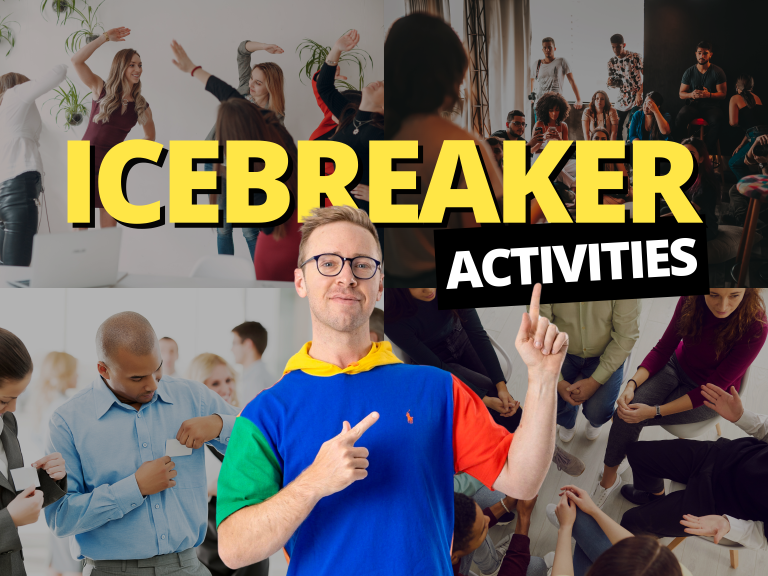Last updated: March 27, 2024
It’s completely natural to feel nervous or overwhelmed when you are getting a group together and want them to socialize.
But don’t let fear stop you!
In this blog post, I’ll teach you how to use icebreaker activities at any event to make sure your guests enjoy themselves and mingle. You will learn:
- What are icebreaker activities?
- Group icebreakers
- Speed icebreakers
- Lightning talks
- Name tag games
- Choosing the Perfect Activity for Your Event
- Best Practices for Implementing Icebreaker Activities
Why you should listen to me: My name is Nick Gray. I have facilitated thousands of events, parties, and social gatherings, employing icebreaker activities in each of these events. My expertise lies in creating an environment conducive to open communication and engagement. However, don't just take my word for it; read on to discover my comprehensive guide to successful icebreaker activities.What are Icebreaker Activities?
Icebreaker activities are interactive exercises or games designed to facilitate introductions, foster communication, and create a positive and engaging atmosphere among individuals or groups who may be meeting for the first time or need to break the ice. These activities are typically used in various settings, such as classrooms, team-building events, conferences, parties, workshops, and social gatherings.
The primary purpose of icebreakers is to create a comfortable and inclusive environment where participants can get to know each other, establish connections, and build rapport. These activities often involve introducing oneself, sharing personal experiences or opinions, and engaging in light-hearted conversations or team challenges. Icebreakers aim to break down initial barriers and social inhibitions, allowing people to feel more relaxed and open to communication.
Icebreaker activities serve as valuable tools for fostering interpersonal connections, establishing rapport, and cultivating a positive team environment. By breaking down barriers and encouraging open communication, these activities lay the foundation for successful collaboration and contribute to the overall success of a group or team.
Different Activities
Since icebreakers act as conversation starters, they will help your guests initiate conversations.
In this section, I’ll show you my three favorite icebreaker activities. I recommend starting with group icebreakers if you are not experienced with hosting gatherings.
Group Icebreakers
Each session of icebreaker should last 5-10 minutes, allowing guests to mingle easily. I recommend doing them every hour or so, depending on the style of the event.
Opt for light-hearted and easy-to-answer questions rather than deep or vulnerable ones. Questions like “What’s your biggest fear?” are NOT suitable for casual gatherings.
Here is an example of questions you should ask each guest for a round of icebreakers:
- What’s your name?
- What do you do for work?
- A simple icebreaker question (e.g., “What’s your favorite breakfast?”)
Three question icebreakers like this effectively set a relaxed tone for any event.
For even more icebreaker questions for you to use, you should read this post: 36 Icebreaker Questions.
Speed Icebreakers
This activity involves guests standing in two lines facing each other and switching partners every 60 seconds to answer a new icebreaker question. It has been proven to increase the number of connections made at parties and creates a lively atmosphere.
I recommend waiting until at least your third or fourth party to use this method since it is difficult to manage the group. Read this blog post to see the in-depth guide for using speed icebreakers.
As with all group announcements, you should lower the music and play your harmonica to get the group’s attention.
Lightning Talks
A lightning talk is a module used by advanced party hosts to boost the energy, excitement, and intellectual stimulation of a party. Consisting of three to five individual talks, each lasting 45-75 seconds, these speeches are often impromptu and delivered by party attendees. Good lightning talks are briefly rehearsed, with some speakers making notes on their phones.
Lightning talks can be used about one hour into the party, usually after a round of icebreakers. They enhance the atmosphere by allowing guests to share topics they’re excited about. This not only makes the party more interesting but also fosters the host’s image as an intellectual and exciting party organizer.
You should identify good speakers during the icebreakers, considering who was comfortable, engaging, and potentially knowledgeable on an intriguing topic. About six people are ideal for lightning talks, which can be done all at once or split into two groups.
The key is to select interested, willing participants who can deliver passionate, brief talks on topics that would add value to the room. The host should approach potential speakers with ease, without pressure, and be excited about the topics they are interested in.
Name Tag Games
Name tag games can be employed to facilitate diverse groupings at parties, especially for larger events or for fostering small-group conversations. This technique uses identifiers such as letters, numbers, or shapes written on name tags to divide guests into different groups.
The activity works best with a minimum of ten people and can scale up to groups of 50. The optimal size for each group is four to six people. Depending on the complexity desired, there are different methods to group guests:
- Two Large Groups: Write “A” or “B” on half of the name tags each. Divide the room into two sections and ask guests with “A” to stand on one side and “B” on the other, then conduct icebreaker activities.
- Multiple Groups: Label the name tags with “A”, “B”, “C”, and “D” or more, depending on how many groups are needed. Divide guests into their respective groups around the room and conduct activities.
- Multiple Groups for Multiple Rounds: This advanced method works best for parties with 16 or more guests and involves more complex group changes. For example, use a combination of letters and numbers (“A1”, “A2”, “A3”, etc.) on name tags. In the first round of icebreakers, guests meet based on their letters. For the second round, they regroup based on their numbers. More rounds can be added by including other identifiers like shapes or Roman numerals.
This activity is definitely for experienced hosts only.
Choosing the Perfect Activity for Your Event
Planning an event is not just about securing a venue and preparing the correct supplies. The activities involved play a pivotal role in the event’s success, and picking the perfect one can turn an ordinary gathering into an extraordinary experience.
Before you can decide on an activity, you must understand the group’s dynamics and preferences. Take into account the group’s age range, interests, and energy levels. For example, if you’re planning a corporate event, a team-building exercise or a networking session might be appropriate.
My personal recommendation for all new hosts, is to start with normal group icebreakers. This will give you experience as a host and set you up for more involving icebreaker activities for your later parties.
You should choose icebreaker questions that allow attendees to share about themselves in a light-hearted manner. Questions like, “What’s your favorite breakfast food?” or “What’s the most interesting place you’ve visited?” are both fun and engaging.
Best Practices for Implementing
As with any activity, the effectiveness of icebreakers depends largely on your ability to implement them. The timing and pacing of the activities, as well as the facilitation techniques, significantly impact the outcome.
Here are some best practices to consider:
- Icebreakers should be initiated at the beginning of an event, serving as a warm-up exercise to set the tone. For an event starting at 7:00 p.m., you could consider running the first icebreaker around 7:10 p.m., followed by others at regular intervals to maintain engagement and interest.
- Clearly communicate the activity’s rules, maintaining an upbeat and positive atmosphere, and ensuring all participants are included.
- Control the duration of each participant’s response to maintain the activity’s pace and ensure everyone gets a chance to participate.
It’s essential to choose icebreaker activities that are suitable for your audience and the event context. The activity should encourage sharing and interaction without making participants feel uncomfortable.
Questions should be light, fun, and easy to answer rather than demanding deep vulnerability or personal revelations. For instance, asking participants about their favorite breakfast food is an excellent icebreaker question that promotes sharing of personal preferences in a casual, non-threatening way.
Case Studies: Using Icebreakers at a Networking Event, Bar, or Party
Mary Beth Yale, a literary consultant who spends her time in Mexico and the United States, successfully utilized icebreakers in various social situations to enhance communication and build relationships.
She employed these techniques in different settings, including a bar and a pre-party gathering, and found them especially effective in engaging people who were initially quiet or unfamiliar. Icebreakers allowed her to delve deeper than surface-level conversations and facilitated bonding over common interests, such as favorite breakfast foods and favorite restaurants.
Mary Beth learned that enthusiasm when introducing icebreakers significantly increased participation and led to enjoyable discussions. Her successful application of icebreakers also gained her a feature in my book.
Adam, a resident of Austin, Texas, demonstrated an extraordinary ability to integrate icebreakers into various social events. His enthusiasm for icebreakers was sparked by the methods prescribed in my book, The 2-Hour Cocktail Party.
He was able to initiate engaging conversations at a restaurant, a Bumble IRL event, a networking event, and another Bumble event, which were previously restricted by limited interaction.
By suggesting they share their names, jobs, original hometowns, and first cars, he was able to bring people together and even inspire others to lead icebreakers. Adam’s proactive use of icebreakers not only enriched his social experiences but also created opportunities for future meet-ups.
Check out their full stories by reading this blog post: How to Use Icebreakers at a Networking Event, Bar, or Party
Conclusion
Whenever you find yourself in a social setting and you want everyone to mingle, try icebreakers. You will quickly become the person who can make any social setting more energetic and enjoyable.
Try the tips and tricks I just wrote about, and your next social event will be a hit. Here are four of my favorite icebreaker activities:
- Group icebreakers
- Speed icebreakers
- Lightning talks
- Name tag games
Let me take a second to introduce myself: Hello! I’m Nick Gray, I wrote The 2-Hour Cocktail Party to help people host their own extraordinary gatherings. Picture a guide that empowers you to effortlessly throw sensational parties for any occasion. The best part? It not only helps you forge new friendships but also creates indelible memories.
Are you planning a party soon? Drop me an email, and I’ll gladly provide you with bonus tips. Moreover, I’m more than happy to address any questions you may have and hold you accountable, completely free of charge. My passion for discussing parties knows no bounds, and my goal is to assist 500 individuals in hosting their inaugural event.


